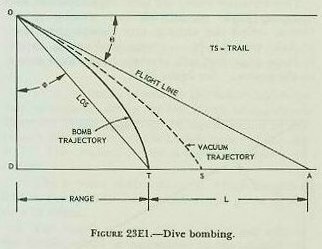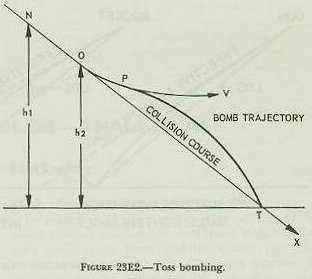| NAVAL ORDNANCE AND GUNNERY, VOLUME 2 CHAPTER 23 AIRCRAFT FIRE CONTROL |
| HOME INDEX Chapter 23 Aircraft fire control A. Introduction B. Aircraft gunnery C. Aircraft weapon systems D. Theory of horizontal bombing E. Other bombing problems F. Rocketry |
| E. Other Bombing Problems 23E1. Dive bombing In dive bombing the plane descends toward the target at an angle of 60 degrees or more, thus imparting considerable vertical velocity to the bomb at the moment of release. In a steep dive, with the bomb released at 2,000 to 6,000 feet, time of flight is short and air resistance, wind, and target motion are small. The problem of obtaining accuracy is simplified and a good percentage of hits can be obtained by use of a simple lead-computing sight. A fixed sight and rule-of-thumb methods may also be used. The plane makes a good AA target, particularly as it pulls out of its dive. In recent aircraft, structural stresses are not too great and a large payload can be carried. Also advantageous is the adverse psychological effect on enemy personnel. 23E2. Glide bombing Glide bombing is similar to dive bombing except that the attack angle is less than 60 degrees. This technique is better adapted to fighter-type aircraft which tend to develop excessive speeds in steep dives. Glide bombing is high-speed attack and bombs are released at an altitude of from 2,000 to 3,000 feet. Advantages over horizontal bombing include surprise and quick getaway. The disadvantages are that the bomb velocity is less than in dive bombing and AA vulnerability is greater than in dive bombing. 23E3. Dive or glide bombing The situation obtained in dive or glide bombing under conditions of no wind is represented in figure 23El. At the point of bomb release, the flight line OA is offset from the line of sight to the target, OT, by the angle AOT. This angle intercepts on the ground a distance L, called the linear aiming allowance. |
 |
 |
| 23E4. Skip bombing In skip or masthead bombing the plane usually attacks at less than 500 feet and the bomb is dropped so close to the target that computation is simple and accuracy high. If the target is a ship, the bomb is released to hit near the waterline just before the plane pulls up to pass over the target. Delay fuzes are employed to give the aircraft time to clear the target. Surprise is highly desirable because the plane is exceedingly vulnerable to AA fire. 23E5. Toss bombing Toss bombing is a technique wherein the pilot dives his plane directly at the target for a short time and then pulls out. The bomb is released automatically during pull-out, the pull-out maneuver giving the bomb additional forward velocity so that it is tossed above the original LOS and its trajectory intersects the original LOS at the target. Bombs can be released at higher altitudes than with dive or glide bombing. It necessitates only a short bombing run, but the plane is within effective AA range and is vulnerable during pull-out. In toss bombing, the airplane is flown initially along a collision course, a straight line path containing the target. If the bomb were released enroute, gravity would cause it to fall short. To overcome this difficulty, the pilot pulls out of his straight-line dive and releases the bomb at a precalculated point along this pull-out curve. The essential geometric features of the problem are indicated in figure 23E2. The straight-line dive at the target T, here considered to be stationary, is begun at a point above N; pull-out takes place at 0 along the curve OP. If the point P is calculated properly and release of the bomb occurs when this point is reached, the bomb trajectory will intersect the target. In the theoretical development we assume the final velocity of the aircraft in the dive to be reached at the point N; and we assume that this final velocity, which we shall denote by V, remains constant along the timing run NO and the pull-up arc OP. |
 |
 |